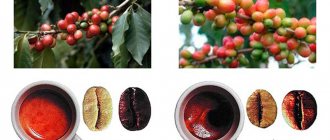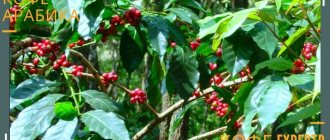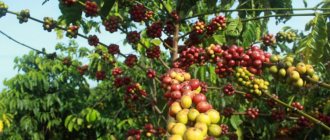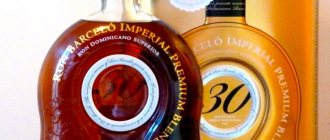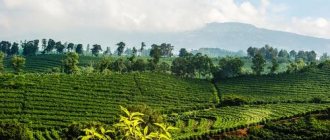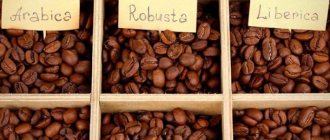Arabica Bourbon is one of the first, most famous and widespread varieties of coffee beans. These are compact but rather tall bushes with green leaves and medium-sized fruits, approximately the same as the Caturra variety, but smaller than SL28 and Maragogype. Bourbon is ideal for cultivation at an altitude of 1600 meters above sea level (as you move away from the Equator, the altitude drops to 1000 meters).
Bourbon is not a very “prolific” variety, which produces average yields (although 20-30% more than Typica), and the plant is also highly susceptible to diseases and parasites. The first fruits appear in the fourth year of the bush’s life. Bourbon has an average need for additional fertilizers and, under favorable conditions, can do without them. The berries ripen early (earlier than Caturra, for example), the recommended planting density is 3000-4000 trees per hectare.
Arabica Bourbon has a great sweetish taste and is very popular in the coffee industry. Bourbon is considered the benchmark for coffee. It is with this that other varieties are compared when talking about their taste and aroma.
History of the origin of Bourbon coffee
Ile de la Bourbon is an outdated name for the rainiest island in the world: nowhere else receives as much rainfall as this small territory in the Indian Ocean. It, like the famous whiskey, was named after the House of Bourbon, a French noble family, the most famous of which is Louis XIV, the Sun King. The French made several attempts to cultivate coffee here, and, in the end, their efforts were crowned with some success, so the new variety was named Bourbon - in fact, also in honor of the king.
Today you will not find this island on the map - it was soon renamed Ile de la Reunion, but the names of the types of drinks remained the same.
Features of growth
Since the climate was particularly humid, after dry Africa, plants had to adapt to new conditions. To grow successfully in soil that was literally saturated with water, the trees produced smaller, rounder fruits. Interestingly, in poor soils, plants also reduce fruit weight, so this is quite typical. Trees usually have large leaves to absorb as much sunlight as possible.
The fruit of the Bourbon coffee tree is always rounder and smaller than the typical Arabica.
Bourbon coffee taste
The range of species of this variety is very diverse. Since the variety spread across the planet, trees have grown in a variety of conditions. For example, acidity greatly depends on the type of soil, the length of daylight hours, and the method of cultivation.
Many plantations are located in rainy regions where typical dry processing is not possible, so washed processing is chosen.
As with all fruits and vegetables, different colored varieties have different sugar and acid compositions. For example, yellow coffee cherries contain a higher total sugar concentration but release less complex flavors when roasted. Thus, yellow cherries lend themselves very well to fruity, sweet flavor profiles, while red cherries produce very balanced, more complex flavor profiles.
It is difficult to describe a specific taste - a lot depends on the manufacturer, roasting, etc., so you need to consider individual brands.
Types, varieties, varieties... What does it all mean?
Now that we know why varieties are important, let's take a step back and look at what these terms actually mean.
According to World Coffee Research (WCR), there are many types of coffee trees, but four are commonly identified: Arabica, Robusta, Liberica and Excelsa. Specialty coffee shops rarely sell anything other than Arabica, avoiding Robusta for its harsh and bitter taste, although some coffee shops rely on Fine Robusta. Liberica is commonly drunk in the Philippines. Excelsa has no particular industrial significance.
Under “species” when describing plants there are “ varieties ”. Species refer to the different variations within a species. For example, Caturra is a variety of Arabica, and Nganda is a variety of Robusta. As for hybrids , this is a variety of coffee that is bred by people under agricultural conditions.
In this case, varieties should refer to cultivars and not to product types.
In many countries, a coffee variety usually refers to the type of product - roasting, origin, etc. This is also facilitated by coffee producers in these countries, often making up the name for the product from the names of varieties, growing regions, or even from names invented by themselves, which brings a certain confusion. Most modern varieties are bud mutations of Coffea arabica var. bourbon and Coffea arabica var. typica, hybrids between them and their mutations. Some may be other varieties or even species and their derivatives, as well as interspecific hybrids. note from Wikipedia
Another thing that confuses many people is the difference in terms between cultivar and variety. Simply put, in English “ variety ” is a noun, and “ varietal ” is an adjective. Although the language is almost as complex as the genetics of coffee, it is possible to use the adjective “varietal” as a noun when talking about coffee rather than plants (this is called nominalization). But this is an article about coffee, not linguistics: suffice it to say that the differences between “variety” and “varietal” are simply grammatical.
In English there is confusion in the terms “variety” and “varietal”, most often meaning both the Type of coffee (Arabica, Robusta...) and the variety/variety (Geisha, Bourbon...). In Russian, everything is more clear: Types of coffee are Arabica, Robusta, and varieties are a smaller division, Typica, Bourbon, Geisha. translator's note
Young sprout of Liberica. Photo: Herbert Peñaloza for 575 Café
Varieties and subspecies of Bourbon coffee
The bourbon line includes Yellow Bourbon, Red Bourbon, Orange Bourbon, Pink Bourbon, and Point Bourbon (also called Laurina or Leroy Coffee). There are also two that emerged as a result of the "French Mission" (1897) - SL 28 and SL 34 (both found in Tanzania and Kenya), Pacas (El Salvador), Villa Sarchi (Costa Rica) and the dwarf form Caturra, from which it later developed the famous Catuaí in Brazil.
Yes, that's quite a lot. Therefore, to illustrate the line of “Bourbon” coffee, we will tell only about the most interesting varieties.
Yellow Bourbon
That same “real Brazilian coffee” is a natural hybrid of Red Bourbon and Amarelo de Butacuto, yellow Typica. Sweet and delicate, with citrus and floral notes. Complex flavors include dark chocolate, brown sugar and nuts, with moderate acidity (but higher than red or orange). It is often added to various blends to add a sweeter overall profile.
Red Bourbon (Red)
Another very popular variety, a natural mutation. It is believed that this is one of the best subspecies of Arabica for gourmets. Clean, light, yet quite bright coffee with a rich aromatic profile. While it is hot, the aromas of sugar and lemon are more noticeable; as it cools, tones of blackberry, red wine and chocolate appear.
Pink Bourbon (Pink)
A hybrid of yellow and red varieties, this subspecies took all the best. The brightest aroma and light body are exactly what many appreciate in a drink. It has bright fruity tones, milk chocolate, and the aroma of orange blossoms. However, depending on the plantation, these may include notes of green apple, apricot and red grapes. The aftertaste is unexpressed, but sometimes with hints of roasted almonds.
Orange Bourbon (Orange or Orange)
Another red-yellow hybrid created by nature, only now towards yellow. Clean, well-balanced, with notes of tart coffee cherry, orange and dark chocolate. The chocolate note carries a delicate astringent aftertaste. A very interesting shade that is appreciated by gourmets.
Bourbon Pointu / Laurina (Pointu, Laurina)
A natural mutation of Bourbon, which originally occurred on Reunion, that same rainy island. Due to this specific climate, it is characterized by very low tree growth and small grains. Interestingly, this variety has a reduced caffeine content, about 0.6%. The taste is sweet and sour, rich and dense, with sour and citrus notes.
Caturra
An exceptionally dwarf modification of red bourbon. It can produce both red and yellow fruits, as well as all their shades. This variety of beans is known for its fresh acidity and smooth body. Lower sweetness and clarity in the cup, sweet fruity wine notes with a bias towards red berries. It was originally grown in Brazil, then the subspecies spread to Costa Rica, Colombia and Nicaragua.
The variety is very great. But definitely, if you value a quality drink, you should try one of these pure varieties if possible.
Varieties you should know
There are many types of coffee in the world, and we won’t even try to talk about them all in one article. However, let's look at some of the most famous and noteworthy varieties of Arabica.
James Hoffman sketches the more common varieties of coffee trees.
Typika
Typica is one of the earliest and most important coffee varieties, which has been around for many centuries and spawned many other varieties. Well-known varieties of Typica include Java, Maragojip and Timor (more on the latter in a moment).
This plant is grown in Central America, Jamaica and Asia. WCR labels it as low yielding, susceptible to coffee rust and pests. Its taste is often described as clean, with sweet acidity.
Maragogyp
Maragogype “One of the most recognizable varieties of the coffee tree, the Typica mutation was first developed in Brazil. It is notable for its unusually large grain size and is therefore very popular. Maragojipa trees are characterized by unusually large leaves and relatively low yields. Due to its impressive size, this coffee is often called “elephant bean”. Ripe fruits are usually red in color...” (James Hoffmann “World Atlas of Coffee”)
Bourbon
A natural mutation of Typica, Bourbon is a high-quality, medium-yielding coffee known for its sweetness. However, it has low resistance to leaf rust, coffee beetle and other diseases and pests. It is commonly grown in Burundi and Rwanda, as well as throughout Latin America.
Why should you know about Bourbon? For the same reasons as with Typica: among the variety of coffee trees, it appeared a long time ago and also gave rise to many other varieties.
Bourbon berries. Photo: Mapache Coffee
Ethiopian heritage
While most Arabica varieties come from Typica and Bourbon, coffee originally originated in Ethiopia. Kew Gardens found that 95% of coffee's genetic diversity is grown in Ethiopia. When you see the “Ethiopian Heritage” stamp on a packet of coffee, it means that the coffee is grown on natural wild or slightly cultivated plantations.
Timor
Timor is a controversial coffee variety because it is a (spontaneous) hybrid of Arabica and Robusta. Robusta is a stronger variety: it is famous for its hardiness and resistance to coffee rust, but it has a less attractive taste and aroma.
As a result, this unique species was used to breed varieties, in particular Catimors and Sarchimors . Catimors appeared as a result of crossing Caturra and Timor, Sarchimors - from the hybridization of Villa Sarchi and Timor. These cultivar groups include Castillo, Colombia and Marsellesa.
Specialty coffee lovers are wary of varieties originating from Timor, but producers, especially if the plantation is not high and this increases the risk of leaf rust, believe that reducing the risk is worth a cup that is possibly cheaper and of lower quality.
Variety of Castillo in the department of Cauca, Colombia. Photo: Finca La Julia
Geisha
It is believed that the plant was first discovered in the Ethiopian village of Gesha, but remained undetected until 2004. The owners of the Hacienda La Esmeralda plantation in Panama, by pure chance, rediscovered the species and appreciated its outstanding properties. Since then, Panamanian Geisha has become one of the most famous coffee varieties. Most finalists of the world coffee championships use this variety for their performances, and recently its price has increased to $803 per pound of green beans (according to the auction as of 07/20/2018, Lot BOP-GN-1: ELIDA GEISHA GREEN TIP NATURAL). Geisha is the personification of perfection and exclusivity.
This variety has a distinctive flavor profile: tea-like with a jasmine aroma, subtly floral, with notes of orange and bergamot.
As for the plant, it grows best at high altitudes (WCR recommends over 1400 meters above sea level). Geisha is a low-yielding and difficult variety to grow. Despite the high prices on the exchange, there are many horror stories from growers who have tried to grow it outside of Panama, which ultimately leads to the death of the plant, which grows in the wrong climate and soil.
Colombian Geisha. Photo: La Palma y El Tucan
Hybrid F1
F1 hybrids are a new generation of coffee varieties that promise to be higher quality, disease resistant and higher yielding. As a rule, they are grown in modern coffee laboratories. One of the famous F1 hybrids is Centroamericano, which recently received high marks at the Nicaraguan Cup of Excellence.
An interesting feature of the F1 hybrid for growers and farmers is that its seedlings are more expensive than other varieties and are more difficult to obtain. Seedlings are grown in special coffee “nurseries” (laboratories) that work with cell cultures, i.e. seedlings are planted rather than grown from seed. This is necessary because trees grown from seed (F2 or next generation) will not have the same excellent qualities as the mother plant. This means that farmers need to purchase seedlings each season rather than germinating the coffee beans themselves. For this reason, WCR recommends that producers purchase F1 only from reputable nurseries.
Ripening of berries.
Caturra
A natural mutation of Bourbon. Caturra is a dwarf tree with average yield, average quality and grain size. WCR even uses the term “Caturra-like” to describe the average yield. The variety is susceptible to diseases such as “leaf rust”, usually grown in Brazil and Latin America. Since it is so common, it is included in this list.
Catuai
Catuai is a cross between Mundo Novo and Caturra, which shares many of the characteristics of Caturra, such as average yield, average grain quality and size, susceptibility to diseases such as “leaf rust” and also has a dwarf tree status.
Yellow Caturra berries. Photo: Ary Nugroho
This is just an introduction to the wonderful world of coffee variety. There are many more varieties that deserve attention: Pacas, Pacamara, Maracaturra, Rume Sudan, Laurina, SL-28, SL-34... The list goes on and on.
Manufacturers, select your varieties more carefully. Do your research to understand all the fears and risks. When planting a new variety, do so gradually, using only a small portion of your farm each time.
As for you coffee connoisseurs, try as many as you can. Pay attention to the differences between varieties, compare different coffees grown in the same region, or the same variety grown in different places. The more you try, the more you will learn about how a variety changes the taste of the drink and you will become a true coffee connoisseur.
Bourbon coffee producers
It's a very confusing area, and if you're looking for information online, it can be difficult to pinpoint what you need. For example:
- Monosort. This is exactly what we are talking about, natural grains with their special taste, from different plantations, a drink for gourmets. For example, Santos Bourbon coffee, which is grown on plantations in the Santos region of Brazil, is quite popular - it’s a classic.
- Bourbon coffee brand. In fact, it's also Bourbon Sobranie coffee. Something that is widely found on the Internet. The Russian brand, which we have already talked about, offers to buy Espresso Bourbon, or Arabica Gold coffee, instant options in beautiful cans.
- Coffee with bourbon, that is, flavored. Of course, there is no alcoholic drink there, just a slight taste and bright smell created chemically. There are a lot of manufacturers, it can be grain, ground, instant.
It is worth understanding that selected specialty grains are not used for instant or mass-produced inexpensive products. If it is “bourbon coffee,” it is usually made from the most inexpensive or substandard beans.
What is the advantage of Bourbon
Bourbon coffee is real Brazilian coffee, which has a creamy taste, original aroma and a tobacco aftertaste. In order for at least someone to try Bourbon coffee in our time, colossal work is being done on the plantations. Moreover, the number of such plantations is limited, because caring for and processing the grains is done manually. Drying of coffee beans is carried out directly on the branches. Bourbon coffee is used primarily to make the perfect espresso. Although no one forbade making any other drink from this type of coffee.
Brazil is a world leader in coffee growing and production. More than one third of the world's coffee comes from Brazil.
Santos coffee trees produce very small fruits for the first 4 years. But this is the highest quality coffee, which has a soft aroma, it is moderately sour and rich.
Bourbon coffee price
Depending on the type of product we discussed above, the cost and options for where to buy it differ. Here are a few options, just to give you an idea of the situation:
- Bourbon coffee from a Russian brand, in glass jars of 100 grams, about 300 - 500 rubles per beautifully decorated jar.
- Lavazza Bourbon Intenso 1 kg – 600 rub. Contains 100% Robusta from Asia. Just a nice name.
- Brazil Yellow Bourbon from Modena Coffee – they promise specialty coffee, – 250 rubles for 250 grams of beans.
- Blues Organic Brasil Bourbon 200 g – 950 rubles. Organic, certified by Switzerland.
- Live coffee – all variants of “bourbon” coffee – about 600 rubles per half kilo.
You can buy bulk products at any supermarket. And what belongs to elite single varieties is better to buy in specialized coffee and tea stores, or in an online store that you trust.
Bourbon coffee reviews
For the most part, those reviews that are found in the Russian-language segment of the Internet refer specifically to the mass-produced instant product. On average, the score fluctuates around 4/5, there are some solid A's and some disappointments.
But if we are talking about high-quality, real bourbon, the ratings here are usually 5/5, because the taste and aroma are truly impressive and memorable. Different varieties have their own characteristics of bitterness, sourness, sweetness and nuances, but they are always good. If possible, try and buy Bourbon coffee directly from where it grows, you are guaranteed to be impressed!
Types of Bourbon
One of the famous Bourbon coffees is Bourbon Espresso. This coffee consists of freeze-dried and ground coffee. Thanks to this coffee you can prepare a real Brazilian espresso. What distinguishes Bourbon Espresso from other coffees is its rich fruity taste and bright aroma. The main secret of this coffee is a mixture of the best varieties of Brazilian Arabica, the beans of which are roasted over very low heat. Of course, the last note of good espresso is the ability to brew it correctly, although Bourbon Espresso is difficult to spoil with anything.
Yellow Bourbon is a very rare Brazilian Arabica that grows only on a few plantations high in the mountains. These coffee trees grow in a favorable climate in southeastern Brazil. This variety was first grown in 1859. The uniqueness of this Bourbon is that it does not undergo any crossing procedure, and the peel of the coffee berries is so thin that it cannot be compared with any other coffee. This causes the sun to warm the berries and grains more, which makes the drink much sweeter. The aroma of coffee is so bright that it will be remembered for a long time. There is a slight sourness, but it quickly disappears.



